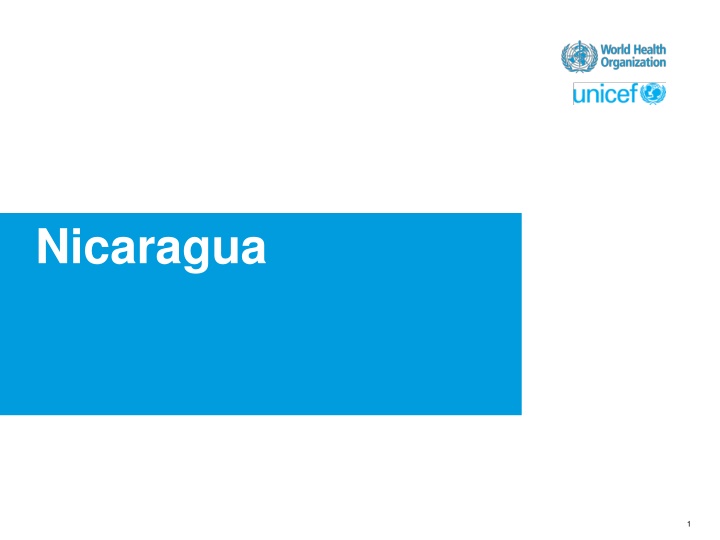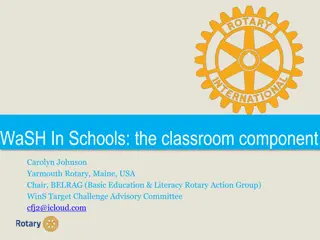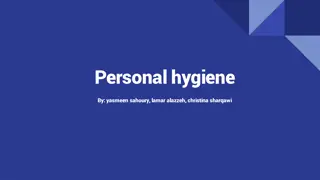Improving Water, Sanitation, and Hygiene in Nicaraguan Health Care Facilities
In Nicaragua, efforts are being made to assess and enhance water, sanitation, and hygiene (WASH) conditions in health care facilities. A baseline study is planned to address the availability and quality of WASH services. Underserved rural areas are targeted for improvement. Initiatives include developing a roadmap for sustainable management of water supplies and waste. Collaboration with global organizations aims to meet national health care standards and Sustainable Development Goals.
Download Presentation

Please find below an Image/Link to download the presentation.
The content on the website is provided AS IS for your information and personal use only. It may not be sold, licensed, or shared on other websites without obtaining consent from the author.If you encounter any issues during the download, it is possible that the publisher has removed the file from their server.
You are allowed to download the files provided on this website for personal or commercial use, subject to the condition that they are used lawfully. All files are the property of their respective owners.
The content on the website is provided AS IS for your information and personal use only. It may not be sold, licensed, or shared on other websites without obtaining consent from the author.
E N D
Presentation Transcript
Nicaragua Population: 6,559,299 2
1. Establish baseline What: Conduct comprehensive assessments according to the national context and, where appropriate, to quantify: the availability and quality of, and needs for safe water, sanitation and hygiene (WASH) in health care facilities; and infection prevention and control (IPC) using existing regional and global protocols or tools and in collaboration with the global effort to improve WASH in health care. Trigger questions on WASH baseline data Q1. Does your country have a baseline for WASH in HCF? If yes, share information below on the status of water, sanitation, health care waste, hygiene and cleaning. If not, share information on your plans for establishing such a baseline. Q2. Have underserved areas been identified? If yes, share information below on what/where these are are and how they are being targeted for improvement. Baseline data/plans for establishing baseline data: Nicaragua don t have a baseline for WASH in HCF. It is proposed to conduct a survey created by WHO at the end of the year 2019. It is ending survey about infection prevention and control, with the information obtained, an improvement plan will be carried out. Information on underserved areas: There is underserved areas in Rural areas. Inclusion of rural investments must be included in guaranteed rural investment projects of health care facilities. 3
2. Develop and implement roadmap What: Develop and implement a road map according to national context so that every health care facility in every setting has, commensurate with its needs: safely managed and reliable water supplies; sufficient, safely managed and accessible toilets or latrines for patients, caregivers and staff of all sexes, ages and abilities; appropriate core components of infection prevention and control (IPC) programmes, including good hand hygiene infrastructure and practices; routine, effective cleaning; safe waste management systems, including for excreta and medical waste disposal; and, whenever possible, sustainable and clean energy. Trigger questions on national roadmaps Q1. Has your country started the process of developing a national roadmap? If yes, what are the key elements included and what is the plan to finalize and implement? Q2. What specific targets are included and how do the activities map to sustainable development goals (SDG) efforts, especially those on WASH and health? Process, key elements & finalization/implementation plans of national roadmap: Nicaragua doesn t have a road map. Since four year it has been implemented a project with World Bank and Interamerican Development Bank to improve the management of medical waste in national, regional and primaries hospital. That project includes helping the health units to improve the maintenance of water supplies system. Targets and linkages to SDGs: With national institutions are still discussing the concepts of SDGs relative to Country and Health Care facilities. 4
3. Establish and implement standards What: Establish and implement, according to national context, minimum standards for safe water, sanitation and hygiene (WASH) and infection prevention and control (IPC) in all health care settings and build WASH and IPC standards into accreditation and regulation systems; and establish accountability mechanisms to reinforce standards and practice. Trigger questions on standards Q1. Does your country have standards for WASH in health care facilities? Q2. What are the key elements in the standards and when were they last updated? Q3. Are there any gaps in these standards and if so, what are these gaps and how will they be addressed? Q4. How are these standards regulated, if at all? The status of national standards including gaps and plans to address: There is minimum standards for safe water, sanitation and hygiene in all health care settings according the national regulation. There is regulation for prevention of infection but it is not at program infection prevention and control. (IPC). The regulations are not recent. Regulation of standards process or plan: It is in process of elaboration the medical waste protocol and update of water regulations. 5
4. Set targets and monitor progress What: Set targets within health policies and integrate indicators for safe water, sanitation and hygiene (WASH) and infection prevention and control (IPC) into national monitoring mechanisms to establish baselines, track progress and track health system performance on a regular basis. Trigger questions on targets and monitoring Q1. What are your targets for WASH in HCF? Q2. Are high risk settings prioritized (e.g. maternity wards)? Q3. What is the process for assessing progress towards achieving these targets? Q4. How is progress incentivized? Overview of targets and prioritization: Monitoring will be established with the results of the WHO for Infection Prevention and Control, handwash and water, sanitation and hygiene surveys. To carry out an improvement plan, the wash fit tool would be used for prioritization. Maternal and child care are priorities. Assessing progress and use of incentives process/plan: Follow up on improvement of indicators. Local governments support improvement of health unit infrastructure. 6
5. Integrate WASH into health programming What: Integrate safe water, sanitation and hygiene (WASH) into health programming, including into nutrition and maternal, child and newborn health within the context of safe, quality and integrated people-centred health services, effective universal health coverage, infection prevention and control (IPC) and antimicrobial resistance. Trigger questions on integrating WASH into health programming Q1. What are the key opportunities in specific national health programmes for WASH in health care facilities? Q2. In what ways has WASH in health care facilities been included (e.g. in training, in monitoring, etc)? Q3. What further integration needs to happen and what is the plan for doing so? Key opportunities for integration & examples: The national antimicrobial resistance program is being developed and water and sanitation in health units was included in one of the lines of action. The infection prevention and control plan is promoted. Opportunities and plans for further integration: Government will invest in water and sanitation in undeserved areas, the inclusion of health care facilities must be guaranteed. 7
6. Allocate regular funding What: Have procedures and funding in place to operate and maintain safe water, sanitation and hygiene (WASH) and infection prevention and control (IPC) services in health facilities, and to make continuous upgrades and improvements based on needs so that infrastructure continues to operate and resources are made available to help facilities access other sources of safe water in the event of failures in the normal water supply, so that environmental and other impacts are minimized and in order to maintain hygiene practices. Trigger questions on regular funding Q1. Have capital and operation and maintenance expenditures for WASH in health care facilities been costed? Q2. Is there a budget line within Ministry of Health? Is so, what is it, and what is the gap? Q3. What plans are in place to fill in, any gaps around costs and financing? Country funding/current budget lines: <It is included in the general health unit maintenance budget. There is no specific line for WASH or infection prevention. The costs are not known and the gap is not known. Plans to address gaps: The gap and needs for finding solutions must be calculated. 8
7. Establish a multisectoral coordination mechanism What: Establish strong multisectoral coordination mechanisms with the active involvement of all relevant ministries, particularly those responsible for health, finance, water, and energy; to align and strengthen collaborative efforts and ensure adequate financing to support the delivery of all aspects of safe water, sanitation and hygiene (WASH) and infection prevention and control (IPC) across the health system. Trigger questions on multisectoral coordination mechanisms Q1. Is there a national multisectoral committee that coordinates, advocates and plans for efforts on WASH in health care facilities? If so, what are the key responsibilities and what has been accomplished to date? Q2. How can such a committee be strengthened? Country multisectoral coordination mechanism, responsibilities & accomplishments: <Inter-institutional and multisectoral coordination is being formed to address compliance with SDG6, establishing this mechanism will positively favour the functioning of the health care facilities. No finance sector or energy sector are included in current committee . Process/plan for strengthening the committee: It is in the process of creation, it is intended to be an official mechanism, where all related sectors are included. 9
8. Develop a health workforce What: Invest in a sufficient and well-trained health workforce, including health care workers, cleaners and engineers to manage WASH services, provide ongoing maintenance and operations and perform appropriate WASH and IPC practices, including strong pre-service and ongoing in-service education and training programmes for all levels of staff; educate and raise awareness, in line with regional agreements, on water, sanitation and hygiene, with a particular focus on maternity, hospital facilities, and settings used by mothers and children Trigger questions on developing a health workforce Q1. What kind of training, mentoring and/or investments in health workforce have taken place to support the safe use and maintenance of WASH in health care facilities services? Q2. Has the WASH FIT or other similar tools been used and adapted? If so, in how many facilities and what has been the key results? Training, mentoring and/or investments in process or planned: Health personnel have been trained in hospital waste management. Use/adaptation of WASH FIT (or other tools) including numbers of facilities and key results: The WASHFIT tool was known recently, it will be applied in three primary care units. In a next workshop, difficulties or facilities for its implementation will be discussed. 10























